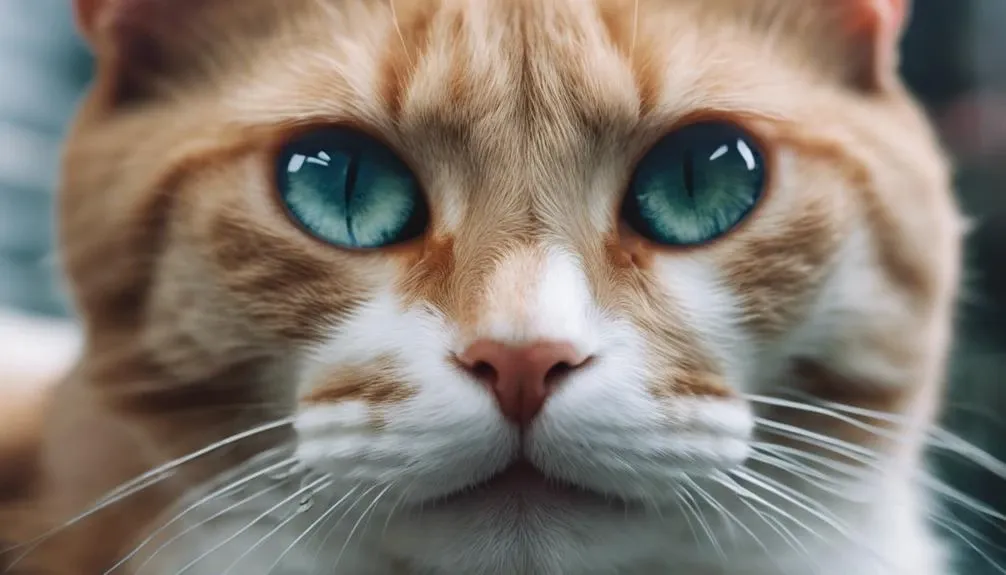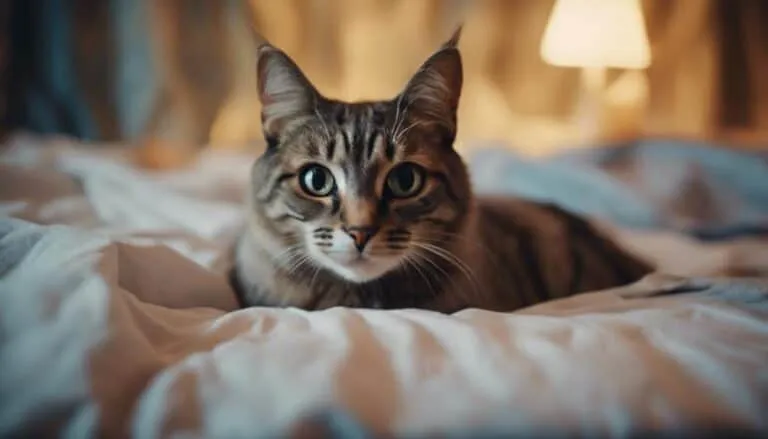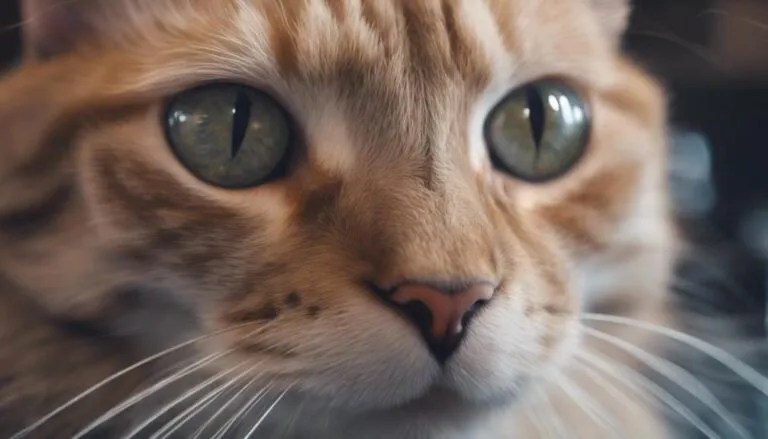The Best Fluffy Pancakes recipe you will fall in love with. Full of tips and tricks to help you make the best pancakes.

You're eager to witness the miraculous transformation of your cat's eye ulcer, hoping for signs that it's healing. As you observe your feline friend closely, looking for subtle changes in their eye condition, you might notice some positive developments.
But how can you be certain that the healing process is truly underway? Stay tuned to discover the key indicators that will help you gauge the progress and eventual recovery of your cat's eye ulcer.
Key Takeaways
- Decreased redness and inflammation
- Reduction in eye discharge amount
- Clearer vision and reduced squinting
- Improved comfort and behavior
Monitoring Changes in Eye Appearance
When monitoring changes in your cat's eye appearance to assess the healing progress of an ulcer, observe for a decrease in redness and inflammation, clarity of the cornea, reduction in eye discharge, signs of reduced discomfort, and compare to the healthy eye for improvements.
A corneal ulcer can be identified by various symptoms, including redness and inflammation in the affected eye. As the ulcer heals, you may notice a gradual decrease in redness, indicating a positive progression.
Another crucial aspect to monitor is the clarity of the cornea. An improvement in cornea clarity suggests that the ulcer is healing. Additionally, a reduction in eye discharge can be a promising sign of recovery.
Observing your cat for signs of reduced discomfort or pain relief related to the eye ulcer is essential to gauge the healing process accurately. Regularly comparing the affected eye to the healthy eye allows you to track improvements in appearance and symptoms effectively.
Reduction in Discharge and Redness
A noticeable decrease in eye discharge and redness indicates positive progress in healing your cat's eye ulcer. Monitoring these changes is crucial for assessing the healing process. Here's what to look for:
- Reduction in Discharge: A decrease in the amount of discharge coming from your cat's eye suggests that the ulcer is responding well to treatment. This decrease is a positive sign that the eye is healing.
- Decrease in Redness: Healing ulcers typically exhibit a reduction in redness around the affected area. This decrease in redness indicates that the inflammation associated with the ulcer is subsiding as the healing process progresses.
- Consistency of Discharge: Monitoring the consistency of the discharge can provide valuable insights into the progression of healing. A gradual reduction in both discharge and redness is a positive indication that the treatment is effective in addressing your cat's eye ulcer.
Improved Comfort and Behavior
To gauge the progress of your cat's eye ulcer healing, observe for enhanced comfort and behavioral changes indicating positive recovery. Improved comfort in your cat can be indicated by reduced squinting, pawing at the eye, or sensitivity to light. Positive changes in behavior, such as increased activity levels or less reluctance to interact, may suggest healing progress. A decrease in eye discharge and redness can be signs that the ulcer is healing effectively. Additionally, a clearer and less cloudy appearance of the eye indicates improvement in the healing process. Remember, regular monitoring by a veterinarian is crucial to provide insights into the healing trajectory and overall progress of the eye ulcer.
| Comfort | Behavior | Indications of Healing |
|---|---|---|
| Reduced squinting | Increased activity levels | Decrease in eye discharge and redness |
| Less pawing at the eye | Less reluctance to interact | Clearer and less cloudy eye appearance |
| Lower sensitivity to light |
Clearer Vision and Response to Light
Improving clarity in your cat's vision and reducing sensitivity to light are key indicators of healing in a cat's eye ulcer. As the ulcer heals, you may notice the following signs:
- Clearer Vision: Watch for reduced cloudiness or haziness in your cat's affected eye. An improvement in visual clarity suggests that the healing process is underway.
- Response to Light: An improved response to light is a positive sign of healing. If your cat shows decreased squinting or blinking in bright light, it indicates that the eye is becoming less sensitive and more comfortable.
- Enhanced Visual Clarity: Look for enhanced visual clarity in the affected eye. This indicates that the healing of the ulcer is progressing well, leading to a clearer and healthier eye overall.
Observing these changes, along with a gradual reduction in eye discharge and redness, can help you track the healing of your cat's eye ulcer effectively.
Follow-up Veterinary Examination Results
During the follow-up veterinary examination, your veterinarian will assess the size and depth of the ulcer to determine healing progress. Observing decreased redness, inflammation, squinting, and discharge are all indicators of the ulcer improving.
Clearing of the cornea and improved vision will suggest successful healing, ensuring your cat's eye is on the path to recovery.
Vet's Assessment Findings
The vet evaluates the healing progress of your cat's eye ulcer by observing reduced redness and inflammation in the affected eye. During follow-up examinations, the vet will look for signs such as:
- Improved comfort level, like decreased squinting or pawing at the eye, indicating positive healing.
- Clearing of any discharge or cloudiness in the eye, which are good indicators of the ulcer healing.
- Performing a fluorescein dye test to track the healing process and monitor for new blood vessel growth (neovascularization) or scarring, helping determine the stage of healing in your cat's eye ulcer.
Healing Progress Update
Upon completion of the follow-up veterinary examination, the healing progress update on your cat's eye ulcer will provide essential insights into the efficacy of the treatment plan. Regular follow-up examinations utilizing fluorescein stain tests offer crucial information about the healing progress of the corneal ulcer. Monitoring the reduction in size and progression of blood vessels post-healing indicates a positive trajectory. Improved cornea transparency and decreased cloudiness are signs of successful ulcer healing. Veterinary assessments play a key role in evaluating the treatment's effectiveness and determining if any adjustments are necessary for optimal healing. Consistent improvements in your cat's comfort, vision, and eye appearance are positive indicators of the healing process.
| Healing Progress Indicators | Description |
|---|---|
| Blood Vessels | Reduction post-healing signifies progress |
| Cornea Transparency | Improved transparency indicates successful healing |
| Comfort Improvement | Enhanced comfort is a positive sign of healing |
| Vision Improvement | Better vision indicates healing progress |
Gradual Decrease in Medication Requirement
Observing a gradual decrease in the amount of medication needed signals positive progress in the healing of your cat's corneal ulcer. Here's why this trend is encouraging:
- Reduced Medication Requirement: A decrease in the frequency and dosage of eye drops or ointments indicates the ulcer is responding well to treatment.
- Diminished Discomfort: As the ulcer heals, your cat may exhibit fewer signs of discomfort or irritation, showing a positive response to the medications.
- Less Pain Relief Needed: Monitoring your cat's need for pain relief medication can serve as a gauge for the ulcer's healing progression, as a decreased requirement suggests improvement.
Frequently Asked Questions
What Are the Stages of Eye Ulcer Healing?
As the eye ulcer heals, clear signs like redness fading and gradual improvement occur. Monitoring progress, using eye drops, and ensuring tissue regeneration are essential. Follow up with veterinary advice and appointments for a successful recovery.
How Long Do Ulcers Take to Heal in Cats?
Healing time for cat ulcers varies based on severity. Monitoring progress through fluorescein tests is key. Reduced squinting, clearer eyes, and neovascularization indicate improvement. Regular vet check-ups track healing. Recovery is crucial for proper healing.
Why Is My Cat's Ulcer Not Healing?
If your cat's ulcer isn't healing, various factors like infections, improper treatments, and underlying issues could be to blame. Consult with a vet for tailored treatment options, infection risks, and necessary lifestyle adjustments for a successful recovery.
Do Corneal Ulcers Scab?
During the healing process, corneal ulcers typically do not scab over. Instead, new tissue forms over the affected area. Monitoring with fluorescein stain tests can track progress. Consult your vet for guidance on assessing healing.
Conclusion
In conclusion, monitoring your cat's eye ulcer for improvements in symptoms such as reduced pain, discharge, and squinting, along with clearer vision and neovascularization, can help assess healing progress.
Regular veterinary examinations and appropriate medication adjustments are crucial for ensuring optimal recovery.
By closely observing these signs and following up with your veterinarian, you can effectively track your cat's eye ulcer healing process and provide the necessary support for a successful outcome.








